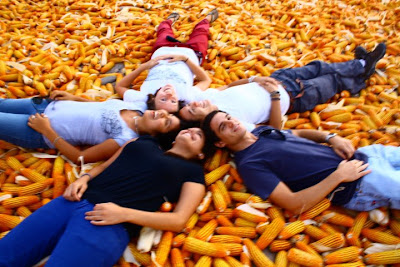The city has gone a bit gray since winter has set in. The ants have subsided slightly and chompas are everywhere. I bought some mittens for at night. But it's still a really pleasant temperature. I wear sandals and get asked constantly ¿No tienes frío!?
On Monday it smelled like seafood and rot in Lima... something having to do with wind patterns and the fish processing plants along the coast. A strange welcome home. At 7am Raighne and I had just gotten off a 15 hour bus ride back from Arequipa... where we had spent the last 5 days visiting Martín, riding horses, walking the city, perusing markets, drinking pre-mixed rum and coke sold in reused Perú Cola bottles, eating birthday cake, learning songs, dancing, riding combis, hanging out in the biggest, baddest convent I've ever seen, and not going to see the condors ni los cañones.
Some pictures:
Gabriel's room (and its view) where we stayed with Martín.
El volcán.
Riding horses ... and motocicletas. (best 10 soles ever spent)
Oh, and we drank a bottle of Chicha with Martín and his friends, which is similar to chica morada but fermented and kind of bubbly. It came in a re-used bottle too, which I'm all about.
Here is Arequipa's Plaza de Armas... as if we didn't have enough pictures of churches. But it really was impressive. After trekking across town to locate two separate vegetarian restaurants that were listed in my guide book but no longer exist and following a sign that said "Vegetarian -->" only to find another place no longer in business, we ate in a place over looking the Plaza. It had a set veg menu which was 3 parts, way delicious and 7 soles. Then we went to the convent:
It's a closed order where 30 nuns and their servants still live in complete solitude. There is a tree there that never blooms. The nuns say when it does, the world will end. We walked around the old quarters for hours. It's huge-- a fortress. It was eerie to think that the women who were sent there were sometimes sent there for the same reasons Irish women were sent to Magdalene Laundries.
Hundreds of women died inside the walls of Santa Catalina.
Talking was completely prohibited for many of the girls.
But there was a range of reasons for women to be there: women pregnant out of wedlock, promiscuous teens, children gifted from fathers, victims of sexual abuse, lesbians, rebelious girls, wives who left abusive husbands, and also rich women who bought themselves a place in the convent. All of them had to work to redeem their "sins," whether forced or out of their own decison. But this work varied drastically depending on what "type" of nun or working girl each woman was deemed to be. This distinction as was also shown by which habbit (if any) each wore.
Being in the kitchens was often where things felt most real for me. There were pots actually used by the women who had lived there and char-marked walls.
But bedrooms with single windows 8 feet off the ground were also rather unnerving .
I'm going to say it: the Roman Catholic Church and its history is wonky as fuck.
Santa Catalina was absolutely immense. The whole experience was fascinating and equally terrifying.



























